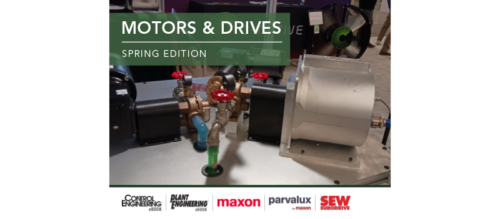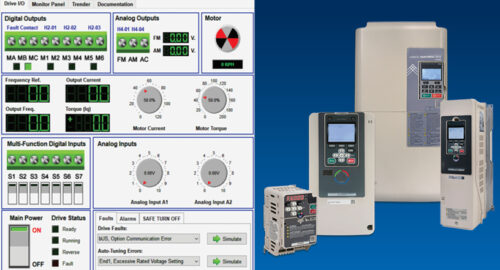How not to install a high efficiency motor
It takes more than just the motor to deliver an efficient outcome.
The Energy Independence and Security Act of 2007 (EISA 2007), which mandates that all new motors sold in the United States must meet a minimum motor efficiency, but does not apply to motors in stock, or rewound motors, went into effect on Dec. 19, 2010.
You would expect that by installing an EISA motor with higher efficiency, one should see a reduction in electrical power consumption along with a reduction in equipment operating cost. If you simply replace an existing motor used to drive centrifugal pumps or a fan with a higher efficiency EISA motor, you may not see as much energy savings as you would expect, and you may not achieve any energy savings at all. We’ll find out how this can happen.
How motor efficiency improvements are achieved
The majority of electric motors in use are 3-phase ac induction motors. In a 3-phase induction motor there are three coils on the stator (the stationary part of the motor). As the alternating current flows into the motor’s stator coils, a rotating magnetic field is established.
The motor’s rotor consists of a shaft along with three separate coils wound into the motor’s rotor. The rotating magnetic field developed by the alternating current flowing through the stator creates an electric current in the windings on the rotor. The current generated in the rotor windings creates a magnetic field that follows the stator magnetic field, resulting in a torque on the rotor that causes it to rotate.
Since the current generated in the rotor windings is created by the movement of the stator’s magnetic field, there must be a difference between the rotational speed of the stator and the rotational speed of the rotor. The difference in rotational speed between the stator and rotor is called slip, and the amount of slip depends on the load on the motor. For example, a two-pole motor connected to a 60 Hz power source has a rotating magnetic field in the stator of 3,600 rpm. If the slip created by a load is 50 rpm, then the motor will rotate at 3,550 rpm. The stator speed is referred to as synchronous speed and the rotor’s speed is called the rotational speed.
Now how does this relate to EISA motors? Higher efficiencies in electric motors are accomplished by using more copper in the windings of the rotor. The larger winding in the rotor provides lower resistance to the induced current in the rotor. This creates a stronger magnetic field in the rotor, resulting in less slip and a higher motor rotational speed.
For example, by reviewing the U.S. Department of Energy (DOE) MotorMaster Program, the average 75 hp standard efficiency motor has a rotational speed of around 3535 rpm with a full load motor efficiency of 94%. A NEMA Premium efficiency motor of the same size (meeting the EISA requirements) has a rotational speed of around 3,555 rpm with a full load motor efficiency of 96%. Notice the NEMA Premium efficiency motor has a 2% increase in full load efficiency and rotates 20 rpm faster than the older standard efficiency motor.
By replacing a standard efficiency motor with an EISA motor with higher rotational speed and higher efficiency on a centrifugal pumping application, you do not see a 2% reduction in pump operating cost that you would expect with a more efficient motor.
The reason for this lack of energy savings can be found in the system. This is what is happening in the system:
- The EISA motor has less slip than the standard efficiency motor, resulting in a higher motor rotational speed.
- Since there is a direct connection between the motor and pump, the pump also runs at the higher rotational speed. This causes the pump head and flow rate to increase based on the pump affinity laws.
- This results in a higher pump discharge pressure, which results in a higher inlet pressure at the control valve.
- The control valve has to throttle more to limit the flow rate to 1,000 gpm, resulting in a higher differential pressure across the control valve.
Since the flow rate through the system is controlled by a flow control valve, the increase in pump head causes an increase in pump discharge pressure, but the flow rate remains the same.
When we look at the total system, the additional head developed by the pump (which takes extra energy to produce) results in a higher differential pressure across the control valve for the same flow rate. So all the additional energy put into the system by the pump is removed by the control valve as heat, noise, or vibration, which negates some of the increased efficiency of the EISA motor.
Let’s see what we need to do to the system to achieve the 2% reduction in power consumption and operating cost that you would expect to see by using the more efficient EISA motor.
If we reduced the pump’s impeller diameter when the pump is connected to the EISA motor running at a higher speed, we could reduce the pump head to the original 228 ft. needed by the system. By trimming the impeller, the pump produces the required 228 ft. of pump head. This results in less energy consumption and achieves the full 2% reduction in annual operating cost you expected to get by investing in the new EISA standard motor.
Conclusion
When you replace an electrical induction motor with a motor with higher efficiency, the motor improvements made to increase the motor efficiency typically will reduce the slip in the motor, resulting in a higher motor rotational speed. If the motor is driving a centrifugal pump, the increase in rotational speed results in an increase in the pump’s head. This additional head developed by the pump at its new higher speed requires additional power from the motor. The only way to take advantage of the higher efficiency motor is to adjust the pump’s impeller to produce the same pump head at the higher motor speed. If this is done, energy savings can be achieved.
If no change is made to the pump impeller, then you will have paid for a high-efficiency motor but will not achieve the full savings in operating cost.
When working with any pumped system, it is important evaluate the total system and not focus on a single item in the system.
Ray Hardee, PE, is a founding principal of Engineered Software. He has over 30 years of experience in evaluating fluid piping systems, with special emphasis on reducing energy consumption in piping systems and increasing plant reliability. Mr. Hardee was a member of the ASME EA-2-2009 Energy Assessment for Pumping Systems. He is the author of Piping System Fundamentals: The Complete Guide to Gaining a Clear Picture of Your Piping System. In addition, he has been actively involved with various Hydraulic Institute/Pump Systems Matters publications on improving the efficiency of pumping systems.
EISA 2007
- General purpose motors (subtype I) manufactured after December 19, 2010, with a power rating of at least 1 horsepower but not greater than 200 horsepower, shall have a nominal full-load efficiency that is not less than as defined in NEMA MG– 1 (2006) Table 12–12 (aka “NEMA Premium” efficiency levels).
- General purpose motor (subtype II), with a power rating of at least 1 horsepower but no more than 200 horsepower, manufactured after December 19, 2010, shall have a nominal full-load efficiency that is not less than as defined in NEMA MG–1 (2006) Table 12–11. Subtype II motors now include:
- U-Frame motor
- design C motor
- close-coupled pump motor
- footless motor
- vertical solid-shaft normal thrust motor (tested in a horizontal configuration)
- 8-pole motor (900 rpm)
- poly-phase motor with voltage of no more than 600 volts (other than 230 or 460 volts).
- Fire pump motors manufactured after Dec. 19, 2010, shall have nominal full-load efficiency no less than as defined in NEMA MG-1 (2006) Table 12-11.
- NEMA Design B, general purpose electric motor, with a power rating at least 200 horsepower but no more than 500 horsepower, manufactured after December 19, 2010, shall have a nominal full-load efficiency that is not less than as defined in NEMA MG–1 (2006) Table 12–11.
- The NEMA MG-1 (2006) Table 12–11 referenced above can be found in the NEMA Premium efficiency standard.
Do you have experience and expertise with the topics mentioned in this content? You should consider contributing to our CFE Media editorial team and getting the recognition you and your company deserve. Click here to start this process.





